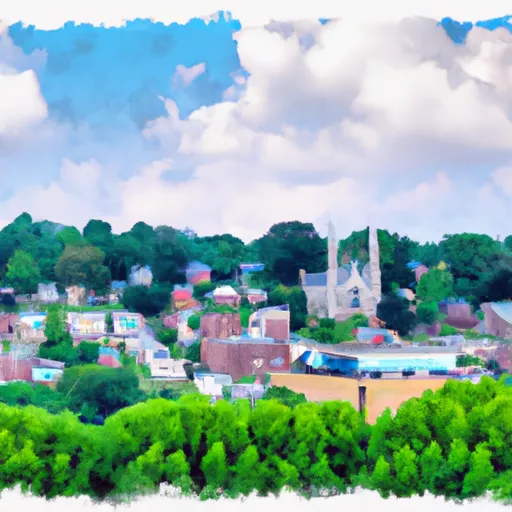-
 Snoflo Premium
Snoflo Premium
Get unlimited access to all our content
With no Ad interruptions! - Start Your Free Trial Login with existing account
Temple
Eden Index
Climate
9.6
•
Recreation
2.8
•
Community
3.0
•
Safeguard
5.6/10

Temple, Pennsylvania is a small borough located in Berks County, in the eastern part of the state. The climate in Temple is considered to be humid continental, characterized by four distinct seasons. Summers are typically warm and humid with average temperatures ranging from the mid-70s to mid-80s Fahrenheit. Winters are cold and snowy, with temperatures averaging in the mid-20s to mid-30s Fahrenheit.
The borough of Temple is not situated near any major bodies of water, but it is crossed by a few small streams and creeks. These hydrology constituents contribute to local biodiversity and provide opportunities for outdoor recreational activities such as fishing and canoeing.
Temple, being located in Pennsylvania, offers a variety of outdoor recreation opportunities. The surrounding area is known for its picturesque landscapes, perfect for hiking, biking, and camping. Some popular nearby destinations include Nolde Forest Environmental Education Center, French Creek State Park, and Blue Marsh Lake. These areas provide ample opportunities for nature enthusiasts to explore trails, observe wildlife, and enjoy various water activities like boating, swimming, and fishing.
Overall, Temple, Pennsylvania offers a diverse climate, modest hydrological features, and a range of outdoor recreation opportunities, making it an attractive destination for nature lovers and outdoor adventurers.
What is the Eden Index?
The Snoflo Eden Index serves as a comprehensive rating system for regions, evaluating their desirability through a holistic assessment of climate health, outdoor recreation opportunities, and natural disaster risk, acknowledging the profound impact of these factors on livability and well-being.
Climate Health Indicator (CHI): 9.6
Temple receives approximately
1210mm of rain per year,
with humidity levels near 76%
and air temperatures averaging around
11°C.
Temple has a plant hardyness factor of
6, meaning
plants and agriculture in this region thrive during a short period during spring and early summer. Most
plants will die off during the colder winter months.
By considering the ideal temperature range, reliable water supplies, clean air, and stable seasonal rain or snowpacks, the Climate Health Indicator (CHI) underscores the significance of a healthy climate as the foundation for quality living.
A healthy climate is paramount for ensuring a high quality of life and livability in a region, fostering both physical well-being and environmental harmony. This can be characterized by ideal temperatures, reliable access to water supplies, clean air, and consistent seasonal rain or snowpacks.
Weather Forecast
Streamflow Conditions
Lower Delaware
Area Rivers
Lower Delaware
Snowpack Depths
Lower Delaware
Reservoir Storage Capacity
Lower Delaware
Groundwater Levels
Recreational Opportunity Index (ROI): 2.8
The Recreational Opportunity Index (ROI) recognizes the value of outdoor recreational options, such as parks, hiking trails, camping sites, and fishing spots, while acknowledging that climate plays a pivotal role in ensuring the comfort and consistency of these experiences.
Access to outdoor recreational opportunities, encompassing activities such as parks, hiking, camping, and fishing, is crucial for overall well-being, and the climate plays a pivotal role in enabling and enhancing these experiences, ensuring that individuals can engage in nature-based activities comfortably and consistently.
Camping Areas
| Campground | Campsites | Reservations | Toilets | Showers | Elevation |
|---|---|---|---|---|---|
| Hickory Run State Park | None | 1,398 ft | |||
| Mauch Chunk Lake County Park | None | 1,050 ft | |||
| Locust Lake State Park | None | 1,260 ft | |||
| Moon Lake County Park | None | 1,133 ft |
Nearby Fishing
Nearby Ski Areas
Catastrophe Safeguard Index (CSI):
The Catastrophe Safeguard Index (CSI) recognizes that natural disaster risk, encompassing floods, fires, hurricanes, and tornadoes, can drastically affect safety and the overall appeal of an area.
The level of natural disaster risk in a region significantly affects safety and the overall livability, with climate change amplifying these risks by potentially increasing the frequency and intensity of events like floods, fires, hurricanes, and tornadoes, thereby posing substantial challenges to community resilience and well-being.
Community Resilience Indicator (CRI): 3.0
The Community Resilience Indicator (CRI) recognizes that education, healthcare, and socioeconomics are crucial to the well-being of a region. The CRI acknowledges the profound impact of these elements on residents' overall quality of life. By evaluating educational resources, healthcare accessibility, and economic inclusivity, the index captures the essential aspects that contribute to a thriving community, fostering resident satisfaction, equity, and social cohesion.

